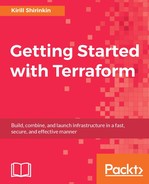If you've read the output of the terraform apply command carefully, you might be really curious about what this part means:
The state of your infrastructure has been saved to the path
below. This state is required to modify and destroy your
infrastructure, so keep it safe. To inspect the complete state
use the `terraform show` command.
State path: terraform.tfstate
What it means is that Terraform didn't simply create an instance and forget about it. It actually saved everything it knows about this instance to a special file, named the state file. In this file, Terraform stores the state of all the resources it created. This file is saved to the same directory where the Terraform template is, with the .tfstate extension. The format of the state file is simple json. Let's take a look at it piece by piece.
{
"version": 3,
"terraform_version": "0.8.2",
"serial": 1,
"lineage": "65a6dc1b-3f42-4f23-8df1-8b2275602aff",
- First of all, Terraform specifies the
versionof thestatefile. It's not the version of this particular state; it's a version of a format ofstatefiles in general. This allows Terraform to move the format of thestatefile forward without breaking compatibility with older versions. - The
terraform_versionkey is self-explanatory: it's the version of Terraform that thestatefile was created with. If you try to use Terraform 0.7 with astatefile that specifies version 0.8.2, Terraform will not allow you to do so. - The
serialkey is increased every time you update yourstate, even with smallest modifications. It is used by Terraform to detect potentially conflicting updates. - The
lineagekey is set only when you create a new state file. After this, the value oflineageis never updated and is not currently used by Terraform. It is planned to be used in order to reduce mistakes when working with remotestatefiles, which we will discuss in later chapters.
What goes next in state file are actually resources you've created. Terraform obtains all the information possible about the resource and writes it to state file:
"modules": [
{
"path": [
"root"
],
"outputs": {},
"resources": {
"aws_instance.hello-instance": {
"type": "aws_instance",
"depends_on": [],
"primary": {
"id": "i-06f88fe6a2b4307b8",
"attributes": {
"ami": "ami-9bf712f4",
"availability_zone": "eu-central-1a",
"disable_api_termination": "false",
"ebs_block_device.#": "0",
"ebs_optimized": "false",
"ephemeral_block_device.#": "0",
"iam_instance_profile": "",
"id": "i-06f88fe6a2b4307b8",You've never specified parameters such as availability zone or disable_api_termination, and yet Terraform has them in the state file.
The state file is what makes Terraform capable of not only creating, but also updating and destroying infrastructure. Terraform knows if the actual state of resources has changed and if parameters in template changed and then it intelligently figures out what the final state should look like and gets your infrastructure to this state.
This makes the state file so important that you never want to lose it after you create your environment. Losing the state file means losing control of your environment through Terraform. It can be very frustrating to create a huge test environment, delete the state file by accident and then delete all resources manually through AWS Management Console.
The state file was not made to be read by humans. But Terraform has multiple commands that allow you to view and modify the state file conveniently. The terraform state list command will list all resources in the state file:
$> terraform state list aws_instance.hello-instance
The terraform show command will print a complete state in a human-readable format:
$> terraform show aws_instance.hello-instance: id = i-06f88fe6a2b4307b8 ami = ami-9bf712f4 availability_zone = eu-central-1a disable_api_termination = false ebs_block_device.# = 0 ebs_optimized = false ephemeral_block_device.# = 0 iam_instance_profile = instance_state = running instance_type = t2.micro key_name = monitoring = false ...
If you want to view the details of only one resource, you can use terraform state show path_to_resource. Running terraform state show aws_instance.hello-instance will give you all the details about the created instance.
After talking so much about how useful the state file is, let's finally use Terraform to update the instance.
